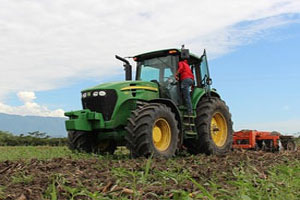
According to a new report from FAO, mechanisation and appropriate mechanisation strategies have a large role to play in improving agriculture productivity, particularly in Africa, in order to feed the growing world population. The opportunity must be guided in a way that meets smallholder farmers’ needs and that does not require a Green-Revolution type of approach with high levels of agrochemical inputs and destructive ploughing operations that threaten soil health and fertility, according to FAO’s new report.
Agricultural mechanisation: A key input for Sub-Saharan African smallholders underlines that agricultural mechanisation in the twenty-first century should be environmentally compatible, economically viable, affordable, adapted to local conditions and, in view of current developments in weather patterns, climate-smart. Mechanisation covers all levels of farming and processing technologies, from simple and basic hand tools to more sophisticated and motorised equipment. It extends far beyond ploughing and can contribute to productivity gains and new jobs in the post-harvest, processing and marketing stages of local and global food systems.
As things stand, two-thirds of the power used to prepare Sub-Saharan African land for farming is provided by human muscle. Comparable rates are 30 percent for South Asia and even lower for Latin America. “There is no doubt that the application of farm power to appropriate tools, implements and machines is an essential agricultural input in sub-Saharan Africa with the potential to transform the lives and economies of millions of rural families,” says FAO assistant director-general Ren Wang, head of the Agriculture and Consumer Protection Department.
“Agricultural mechanisation in its broadest sense can contribute significantly to the sustainable development of food systems globally, as it has the potential to render post-harvest, processing and marketing activities and functions more efficient, effective and environmentally friendly,” he added.
FAO emphasises that harvesting the fruit of productivity-boosting mechanisation in Sub-Saharan Africa depends on making available and accessible appropriate means of farm power supply. This ranges from draught animals to two-wheel and four-wheel tractors. There is a wide variety of agricultural equipment for precision seeding with minimum soil disturbance, efficient planting and transplanting of seedlings, application of inputs, harvesting and transport, processing and value addition that cover the mechanisation spectrum. It is, therefore, important to assure adequate land tenure and credit systems to encourage investments in mechanization.
Sustainable crop production intensification includes soil protection, ample cover crops and minimal tillage – all key principles of FAO’s ecosystem-based “Save and Grow” paradigm and directly supporting the 2030 Sustainable Development Agenda, especially SDG2 to “End hunger, achieve food security and improved nutrition and promote sustainable agriculture”.
